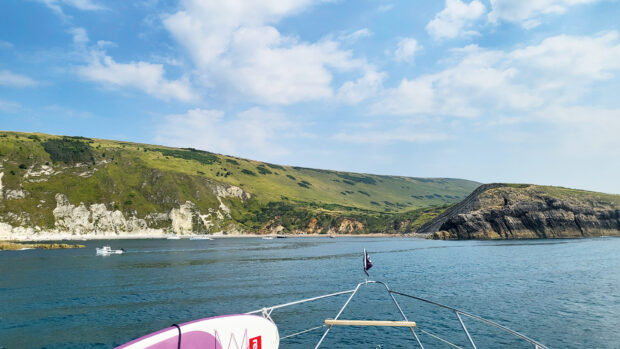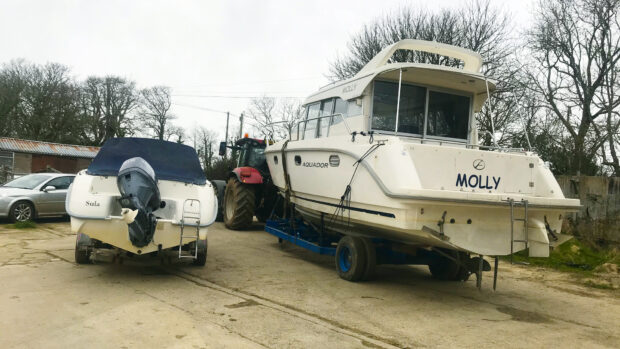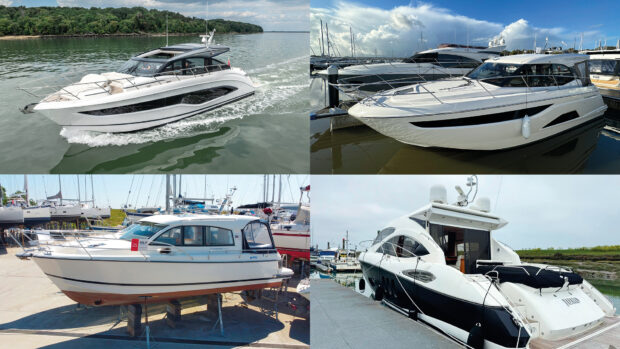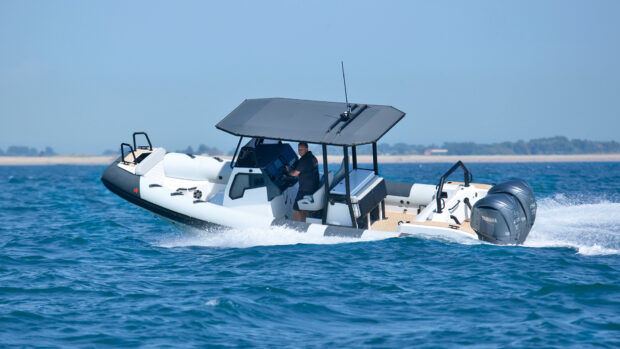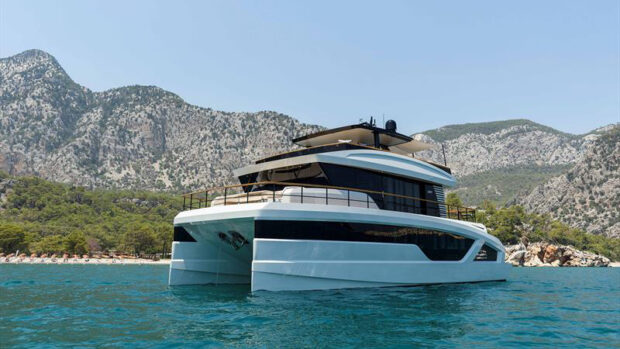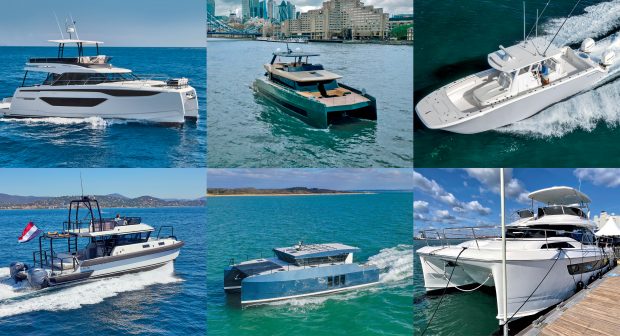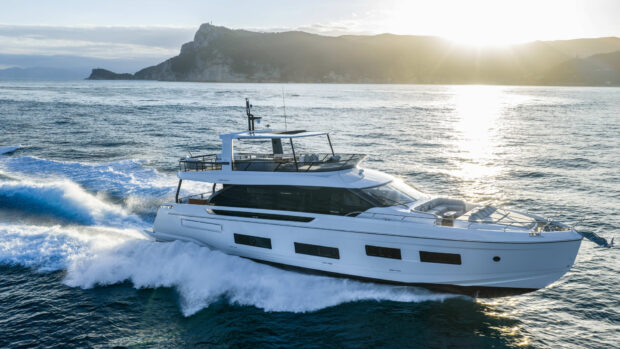Early in 2020, with Covid not even a cloud on the horizon, two Broom Owners Club members, Keith and Carole Rowe, were developing plans for the summer. Their idea was to organise an international gathering of Brooms in Dutch waters, leading the British contingent across the North Sea from Norfolk, the home of Broom Boats.
We all know what happened next. With lockdown scuppering all activities for 2020, they postponed it to the following year and used the time to develop the idea further. They identified a suitable location, a picturesque marina next to the historic town of Naarden, and got others involved to bolster attendance.
As committee rep for Europe, I was brought into the discussions and offered my support, although I was not initially planning to take our boat there. With La Strega based in southern France, the journey through the canals and rivers of Europe would take too long, so we would instead be flying over to join them.
Then came the second lockdown and by Spring 2022 Marjorie and I were ready for a challenge, even if it meant 1,200km across four countries and 150 locks in 26 days. The story of that voyage has been recounted in the previous articles:
Article continues below…

Boating across Europe: ‘The sun was illuminating the hillsides with familiar names of Moselle wines’

Boating across Europe: ‘Traffic was very light and by lunchtime we had covered 25km and passed three locks’
Sinking feeling
We made it to Zaandam marina, the agreed assembly point for boats coming from the UK, on Monday 6 June, three days ahead of schedule. Keith’s boat was already there, having crossed the North Sea in April to get everything organised. The four other UK-based Brooms we were expecting (three 415s and a 39) were waiting in Lowestoft for better weather. Ideally, they wanted a sea state that would allow them to complete the 105-mile crossing to IJmuiden in around six hours.
Marjorie and I spent a few hours exploring Zaandam, enjoyed an excellent meal in one of the many restaurants, then decided we should use our free time to recover our car from St Jean de Losne. This involved a complicated train journey, an overnight stop in Dijon, then a 600-mile drive the next day.
Back at Zaandam, late Wednesday, we found the four Brooms had recently arrived, but with a tale of drama and near disaster on the crossing. Despite rougher than ideal conditions they had been making steady progress when, with about 25 miles to go, the crew of the Broom 39 noticed they were losing speed.

La Strega reached Zaandam marina three days early
Looking below decks they found water in the aft cabin.
A check of the engineroom soon revealed the source, water spraying uncontrollably from the starboard engine cooling feed. Attempts to stop the engine failed, as the solenoid switch was waterlogged. It was only by closing the fuel feed that they eventually managed to stop it. Listing heavily from the weight of water, they limped into IJmuiden on one engine, with the other three boats standing by.
Once in harbour, with the remaining water pumped out, the cooling hose fixed and the electrics dried off, they got the starboard engine restarted and completed the last few miles up the North Sea Canal to Zaandam. The atmosphere that evening was understandably a bit subdued.

The fuel convoy heads off on a collective bargaining hunt
Fuel for thought
Happily, Thursday morning dawned bright and sunny, lifting everyone’s spirits. As we got to know the new arrivals and learned more about the previous day’s experiences, the conversation moved on to preparations for the weekend.
All four boats had arrived with near empty tanks and refuelling was a priority. That reminded me that we were in a similar position. The skipper of the 39 knew of a fuel barge close by and suggested we all go together, as big volumes usually meant a lower price per litre.
Collectively, we reckoned we would need over 2,000 litres, so we set off in convoy to see what sort of deal we could get. I never heard the initial price but was happy to get our tanks filled (390 litres) for E2.00 per litre. That worked out at 4.2mpg for the second half of our journey, record economy for La Strega, illustrating the advantages of travelling downstream at moderate speed.

A tailwind made Oranjesluizen tricky to negotiate
Back at Zaandam, the crew of the “nearly sunk” 39 invited everyone on board to celebrate their survival. What started as an informal drink developed into a party that went on well into the evening, leaving a few of us feeling less than fully fit for the short cruise to Naarden next morning.
The plan had been to reach Naarden around noon, in good time to welcome the “Continentals” (Broom owners with boats based in mainland Europe). But by the time the hangovers had cleared enough for us to get going, it was already the afternoon.
Nevertheless, we enjoyed cruising through Amsterdam in company with five other Brooms. There was a little difficulty getting the fleet through Oranjesluizen due to a fresh tailwind pushing us into the lock, but we made it through in two batches.
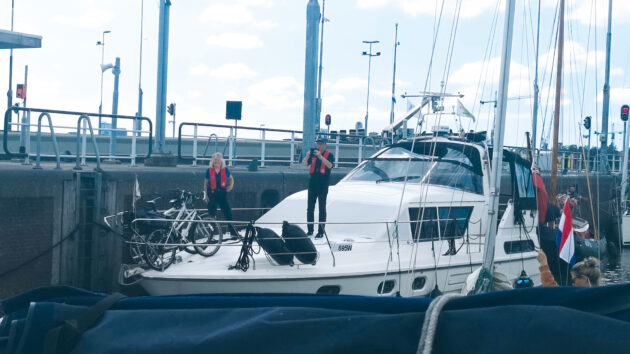
Event organisers Keith and Carole Rowe
Pride of place
Once out into the IJsselmeer, the cruising became a bit more ‘competitive’, leaving La Strega trailing in the wake of the larger, faster boats. Arriving last at Naarden, we saw 16 Brooms moored in pairs, filling what looked like all the available space. Getting closer, we were greeted with the news that they had saved the prime mooring for us – brilliant but for the fact that it meant reversing past all the double-moored boats, in front of a friendly but critical crowd of observers!
Actually, it was not a problem and once moored, I was truly grateful for the prime space saved for us. Stern-on to the main quay, we had easy access to all the marina facilities. It also gave us the chance to meet everyone else as they walked past. There were no formal plans for the Friday evening but it was great to meet all the new faces and to entertain a good number of them on our (relatively) tiny aft deck.
Saturday morning, after coffee and croissants on deck, we got out our folding bikes and set off for our first visit to Naarden town. Amongst the pretty cobbled streets, we found a busy open-air market close to the ancient citadel, now converted to an events venue. Preparations were under way for a wedding there, and the whole town looked ‘en fête’.

Broom boy racers on IJsselmeer
For the afternoon, club members were divided into two groups for guided tours of the town, by boat and on foot. The boat took us on a canal, originally a moat outside the town walls and part of the impressive defences against attack from land or sea.
We enjoyed an excellent commentary on the design and construction of the fortress, before swapping with the other group for a guided walking tour of the town and historic buildings. Their efforts clearly worked as Naarden never suffered an attack from land or sea, unlike several less well defended Dutch towns which were destroyed by Spanish raiders during the Middle Ages.
After the tour we lingered over coffee in the Cathedral square, chatting to an English couple who moor their Broom in Holland, and a Dutch couple, Rene and Elsbeth Gorter, who had spent time exploring French inland waterways in their Broom Continental. We also discovered that Elsbeth is an artist, who painted some lovely watercolours of the gathering.

Pampus Island looks calm but strong winds are on their way
By the time we returned to the marina, the fires were already lit for the evening’s group barbecue. We gratefully accepted an invitation to share cooking facilities with an Australian couple, who keep their boat in Holland, and after dinner, spent time with the German couple who had given us invaluable help, planning our trip down the Moselle and Rhine. We enjoyed a tour of their splendid 415, chatting over a few more beers before bed.
Sunday was reserved for a visit to Pampus Island, another historic fortification, but much more modern than the walls and moat surrounding Naarden. Pampus is an artificial island created in the 1870s, just 60 years before the Afsluitdijk enclosed the IJsselmeer, effectively eliminating possible attacks on Amsterdam by sea.

Painting by Elsbeth Gorter showing the windy Pampus moorings
Tunnel vision
Built to similar standards as the Maginot Line, and equally ineffective in preventing the German advance in WW2, it is now a historic monument, accessible only by boat. The harbour was only big enough for the regular service craft and one other, but Keith had obtained permission for our party to make the four-mile crossing in four of our boats, conditional on three of us mooring between piles on the outside.
Mooring in calm conditions was straightforward and we enjoyed our guided tour of the facilities, designed to enable the fortress to withstand an extended assault. However, when we emerged from the tunnels, looking forward to lunch on the island, we saw that the wind had got up and waves were now threatening the boats moored outside, blowing them onto the jetty.
Lunch was forgotten, and it was all hands to the jetty. With some impressive teamwork and excellent throttle control by skippers, all three boats were reversed out to open water. Thankfully, no damage was done but it was a good lesson on the risks of being caught in open water on the IJsselmeer.

A final atmospheric dinner in Naarden Citadel
European reunion
Safely back in the marina, we had time to get dressed and ready for the formal dinner served in Naarden Citadel, the venue of Saturday’s wedding. There were 40 members round the table that evening, 35 of us from the 17 boats, plus five who had come by car. Collectively, we represented at least five European nations.
For Marjorie and me it was a great experience, making new friends and catching up with others we had known since the Club was formed in 2004. It’s amazing how people bond over a shared love of boats, perhaps even more so when it includes shared appreciation of owning a much-loved but no longer active marque like Broom!
As we assembled for the group photo on Monday morning and said our farewells, plans were already being made to do it all again next year. We may have had the ‘Longest Journey’ by boat, if not the toughest, but it was well worth the effort.
 If you enjoyed this….
If you enjoyed this….
Motor Boat & Yachting is the world’s leading magazine for Motoryacht enthusiasts. Every month we have inspirational adventures and practical features to help you realise your sailing dreams, as well as tests and news of all the latest motorboats.
Plus you’ll get our quarterly Custom Yachting supplement where we share the last on offer in the superyacht world and at the luxury end of the market.
Build your knowledge with a subscription delivered to your door. See our latest offers and save at least 30% off the cover price.
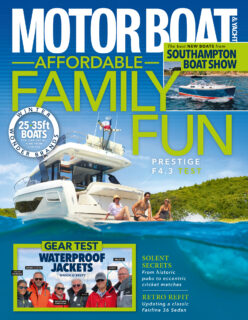


 If you enjoyed this….
If you enjoyed this….